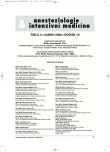-
Medical journals
- Career
LMA-ProSeal™ laryngeal mask is a safe option for securing the airways for laparoscopic cholecystectomy
Authors: Zvoníčková Dagmar; Zvoníček Václav; Klimeš Jiří; Volčík Aleš; Pelikán Karel
Authors‘ workplace: Anesteziologicko-resuscitační klinika, LF Masarykovy univerzity a Fakultní nemocnice u sv. Anny v Brně
Published in: Anest. intenziv. Med., 19, 2008, č. 2, s. 77-81
Category: Anaesthesiology - Original Paper
Overview
Objective:
The aim of study was to find if LMA-ProSeal™ safely protects the airways during laparoscopic surgery.Type of study:
Prospective study.Setting:
Department of Anaesthesiology and Intensive Care, University Hospital.Materials and methods:
Patients undergoing elective laparoscopic cholecystectomy were enrolled in the study. The results are presented as the median and the inter-quartile range, the statistical significance was evaluated by Mann-Whitney U Test and Wilcoxon match paired test.Results:
Ninety-seven patients (M:F 35 : 62) aged 54 (37–64) years of age with body mass index (BMI) 26 (23–29) kg . m⁻² were enrolled in the study. Twenty-one patients (22%) were classed as severely obese (BMI > 30 kg . m⁻²). PLMA was inserted on the first attempt in 75 cases (77%), on the 2nd attempt in 14 patients (14%) and in the remaining 8 (8%) patients the insertion was successful on the 3rd attempt after a change of size of the PLMA. The PLMA cuff pressure was 40 (35–40) cm H₂O at the beginning of surgery; the capnoperitoneum pressure reached 13 (12–14) mm Hg. Peak airway pressure at the beginning of surgery (Pstart) was 17 (15–21) cm H₂O and increased to 22 (19–25) cm H₂O after CO₂ insufflation (Pcapno). Patients with BMI > 30 had higher Pstart [21(16–23) vs 17(14–20) cm H₂O; p = 0.002] and Pcapno [25 (22–30) vs 22 (19–25) cm H₂O; p = 0.001]. The difference between Pstart and Pcapno was also significant (p < 0.001).
A nasogastric tube was successfully inserted on the 1st attempt in 99% of patients. In one patient a ”fold-over” position was revealed. No gastric contents were found in 40 (41%) patients at the end of surgery; in the remaining patients a residuum of 20 ml (10–30 ml) was detected. Regurgitation of gastric juices occurred in 3 patients. No signs of lung aspiration were found.Conclusion:
PLMA is a safe method of airway protection during laparoscopic surgery.Keywords:
laparoscopic cholecystectomy – inspiratory pressure – regurgitation – pulmonary aspiration – laryngeal mask
Sources
1. Brain, A. I. J. The LMA ProSeal: a laryngeal mask with an oesophageal vent. Br. J. Anaesth., 2000, 84, p. 650–654.
2. Kihara, S., Brimacombe, J. Sex-based ProSeal laryngeal mask airway size selection: a randomised crossover study of anesthetized male and female adult patients. Anesth. Analg., 2003, 97, p. 280–284.
3. O’Connor, C. J. Jr., Davies, S. R. O. V., Stix, M. S. “Soap bubbles“ and “gauze thread“ drain tube tests. Anesth. Analg., 2001, 93, p. 1082.
4. O’Connor, C. J. Jr., Borromeo, C. J., Stix, M. S. Assessing ProSeal laryngeal mask positioning: the suprasternal notch test. Anesth. Analg., 2002, 94, p. 1374–1375.
5. Brain, A. I. J. The laryngeal mask – a new concept in airway management. Br. J. Anaesth., 1983, 55, p. 801–805.
6. Lu, P. P., Brimacombe, J., Yang, C. et al. ProSeal versus the Classic laryngeal mask airway for positive pressure ventilation during laparoscopic cholecystectomy. Br. J. Anaesth., 2002, 88, p. 824–827.
7. Maltby, J., Roger, Beriault, Michael, T., Watson, Neil, C. et al. The LMA-ProSealTM is an effective alternative to tracheal intubation for laparoscopic cholecystectomy. Canadian Journal of Anesthesia, 2002, 49, p. 857–862.
8. Bimla, S., Chand, S., Abhijit, B. et al. Proseal Laryngeal Mask Airway: A Study of 100 Consecutive Cases of Laparoscopic Surgery. Indian Journal of Anaesthesia, 2003, 47, p. 467–472.
9. Rao, R. S., Nair, S., Nair, N. S., Kamath, V. G. Acceptability and effectiveness of a breast health awareness programme for rural women in India. Indian J. Med. Sci., 2005, 59, p. 398–402.
10. Stix, M. S., O’Connor, C. J., Jr. Depth of insertion of the ProSeal laryngeal mask airway. Br. J. Anaesth., 2003, 90, p. 235–237.
11. Keller, C., Brimacombe, J. Mucosal pressure and oropharyngeal leak pressure with the ProSeal versus laryngeal mask airway in anaesthetized paralysed patients. Br. J. Anaesth., 2000, 85, p. 262–266.
12. Roberts, C. J., Goodman, N. W. Gastro-oesophageal reflux during elective laparoscopy. Anaesthesia, 1990, 45, p. 1009–1011.
13. Halevy, A., Kais, H., Efrati, Y. Continuous esophageal pH monitoring during laparoscopic cholecystectomy. Surg. Endosc., 1994, 8, p. 1294–1296.
14. Brimacombe, J. R., Berry, A. The incidence of aspiration associated with the laryngeal mask airway. A meta–analysis of published literature. J. Clin. Anesth., 1995, 7, p. 297–305.
15. Warner, M. A., Warner, M. E., Weber, J. G. Clinical significance of pulmonary aspiration during the perioperative period. Anesthesiology, 1993, 78, p. 56–62.
16. Cook, T. M., Nolan, J. P. The Pro-Seal laryngeal mask airway. Anaesthesia, 2002, 57, p. 288–289.
Labels
Anaesthesiology, Resuscitation and Inten Intensive Care Medicine
Article was published inAnaesthesiology and Intensive Care Medicine

2008 Issue 2-
All articles in this issue
- The theory and simplified mathematical model of multi-level intermittent positive pressure ventilation
- Tri-level pulmonary ventilation (3LV®) – initial clinical experience
- Epidemiology of invasive candidiasis and candidemia – a persistent problem
- LMA-ProSeal™ laryngeal mask is a safe option for securing the airways for laparoscopic cholecystectomy
- Intramuscular dexmedetomidine in burns victims – preliminary results
- Dexmedetomidine-ketamine intravenous sedation during local anaesthesia
- Classification of infections in intensive care and a comparison of their incubation period and carrier status
- Anaesthesiology and Intensive Care Medicine
- Journal archive
- Current issue
- Online only
- About the journal
Most read in this issue- Epidemiology of invasive candidiasis and candidemia – a persistent problem
- LMA-ProSeal™ laryngeal mask is a safe option for securing the airways for laparoscopic cholecystectomy
- Tri-level pulmonary ventilation (3LV®) – initial clinical experience
- Dexmedetomidine-ketamine intravenous sedation during local anaesthesia
Login#ADS_BOTTOM_SCRIPTS#Forgotten passwordEnter the email address that you registered with. We will send you instructions on how to set a new password.
- Career

